Effective Strategies for Eliminating Wasp Nests
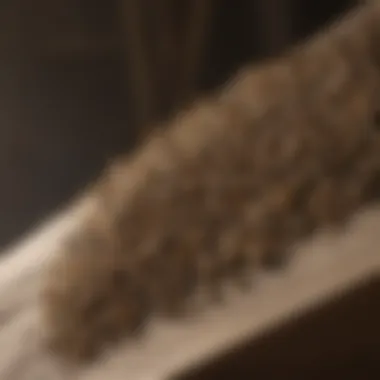
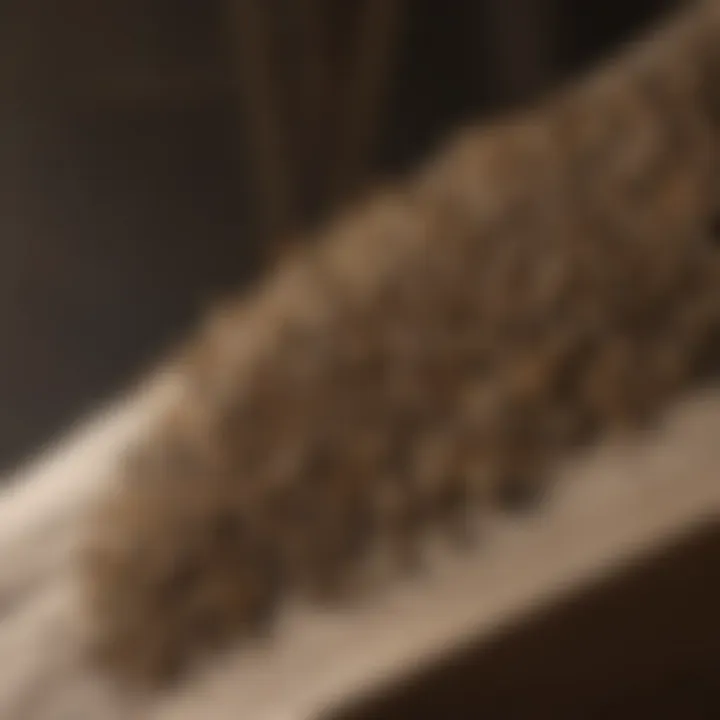
Intro
Dealing with wasp nests can be a daunting task for many homeowners. Understanding these pests and how to approach their removal is essential for maintaining a safe living space. Wasps can be aggressive, especially when their nests are disturbed, leading to painful stings. This article will guide you step-by-step through effective strategies for eliminating wasp nests found in roof spaces. By focusing on identification, safety, and eco-friendly methods, you will be better equipped to handle these unwanted guests.
Understanding Pests
Definition of Pests
Pests are organisms that negatively impact human activities by causing harm or damage to property, crops, and health. In this context, wasps, particularly those building nests in roof spaces, pose a risk not only through their potential stings but also through the structural damage they may cause.
Importance of Pest Identification
Proper identification of wasp species is crucial. Not all wasps behave the same way; some are more aggressive than others. Misidentification can lead to improper handling and increased risk. For example, yellowjackets and hornets may establish nests that look similar but require different removal strategies. Knowing what type of wasp you are dealing with allows for a tailored approach to removal and prevention.
Prevention Techniques
Home and Garden Preventative Measures
Preventing wasps from nesting in the first place is a proactive strategy. Here are a few simple measures:
- Seal Openings: Thoroughly inspect your home for cracks and gaps. Seal these areas to prevent wasps from entering.
- Remove Food Sources: Wasps are attracted to food. Keep outdoor dining areas clean, and secure garbage cans with tight lids.
- Discourage Nesting: Hang decoy nests in your garden. Many wasps are territorial and may avoid areas where other nests are present.
Seasonal Prevention Tips
Certain times of the year are more conducive to wasp activity. Here are some seasonal tips:
- Late Winter/Early Spring: This is the time to inspect your home before wasp activity increases. Look for signs of early nesting.
- Summer Months: Regularly check your garden. Easy access to food sources can attract wasps. Maintain cleanliness during this period.
Eco-Friendly Pest Control Solutions
Overview of Sustainable Practices
Using eco-friendly methods for wasp control reduces negative impacts on the environment. This includes employing non-toxic removal methods and products. For instance, using essential oils like peppermint can deter wasps without harmful chemicals.
Natural Remedies and Their Effectiveness
Natural remedies can be effective in managing wasp populations. Here are a few you can try:
- Peppermint Oil: Mix water with peppermint oil in a spray bottle. Spraying this in areas where wasps are active can repel them.
- Vinegar Traps: A mixture of vinegar and sugar can attract and contain wasps effectively.
By understanding the biology of wasps and implementing proper procedures, you can manage these pests responsibly.
In summary, the approach to managing wasps involves not just removal but also awareness of prevention and sustainable practices. Following the outlined strategies will contribute to maintaining a safe and pleasant environment around your home.
Intro to Wasp Nests
The topic of wasp nests is more than just a home maintenance issue; it reflects a balance between human habitation and nature. Understanding wasps is vital for any homeowner facing potential infestations in their roof spaces. This section provides essential insights into wasp behavior and the common types of wasps you may encounter. Grasping these concepts is key to effectively managing nests and mitigating risks associated with their presence.
Understanding Wasp Behavior
Wasp behavior is crucial to address when considering removal strategies. Wasps are generally social insects, living in colonies that can range from a few dozen to several thousand members, depending on the species. They are known for their protective nature towards their nests. Therefore, understanding their patterns can provide useful information about when to approach removal.
Wasps are often attracted to certain environmental factors. For example, they prefer warm weather patterns, which explains why they may establish their nests in the roofs of homes during spring and summer. Notably, their nesting period often leads to increased aggression, especially if the nest is disturbed. Homeowners need to observe activity around their roof spaces regularly. Recognizing wasp behavior can lead to more precise timing for removal efforts, which is important for safety.
Common Species of Wasps Found in Roofs
Several species of wasps are known to inhabit roof spaces in residential areas. Identifying these species is vital for determining appropriate removal strategies. Here are some of the most common wasps you may encounter:
- Yellow Jackets: These wasps are highly aggressive and may form nests in walls or ceilings. They are identifiable by their distinctive yellow and black markings.
- Paper Wasps: Known for their umbrella-shaped nests made of papery material, these wasps are generally less aggressive but can still sting when disturbed.
- Hornets: A larger type of wasp that can cause significant damage to property with their nests, hornets tend to be more territorial.
- Mud Daubers: These solitary wasps do not form colonies like others, often creating nests from mud. They are less threatening compared to other species.
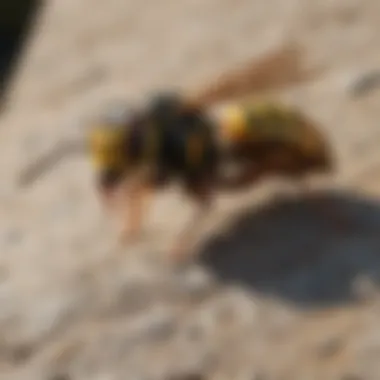
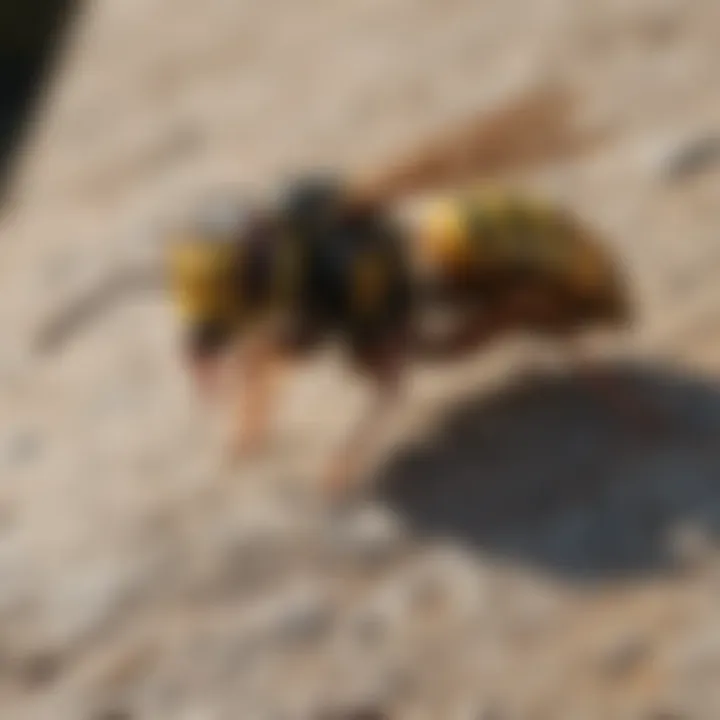
Understanding the species that might inhabit your roof is essential for effective management strategies. Each type has distinct characteristics and behaviors that can influence removal approaches. Homeowners should take note of the type of wasp present, as this can directly impact their safety and the success of any removal efforts.
Identifying the Presence of a Wasp Nest
Identifying the presence of a wasp nest is crucial for any homeowner. This step is pivotal because early detection can significantly minimize the risks associated with wasps, such as stings or damage to the property. Moreover, understanding where a nest is located can guide effective and safe removal.
Signs of Wasp Activity
Recognizing signs of wasp activity is the first step to identifying a nest in your roof space. Some common indicators include:
- Visible Wasps: If you notice wasps flying in and out of a specific area, it is likely they are nesting nearby.
- Nesting Material: Look for bits of paper-like substance near the eaves or roof. Wasps often use wood fibers mixed with saliva to build their nests.
- Vocalizing Sounds: If you hear a buzzing noise, it might be due to a large population of wasps nearby.
- Nesting Behavior: Observing wasps carrying food or materials to a secluded area can also suggest nesting activity.
These signs not only help in confirming the presence of a nest but also indicate its proximity, which is important for planning an appropriate response.
Locating the Nest
Once you suspect wasp activity, the next step is locating the nest itself. This process can involve careful observation and sometimes a bit of patience. Here are various methods to help you find the nest:
- Follow the Flight Path: Observing the flight patterns of wasps can lead you directly to their nest. Stand at a safe distance and look for areas where they frequently enter and exit.
- Check Common Nesting Areas: Wasp nests are often found in sheltered spaces. Inspect areas such as:
- Use a Flashlight: If the nest is located in a dimly lit area, utilizing a flashlight can help illuminate the space and reveal a hidden nest.
- Listen for Sounds: If you are unsure about the location, quietly listen for the buzzing noise of wasps. This can help pinpoint the nest without drawing attention to yourself.
- Under roof overhangs
- Inside attic rafters
- Behind siding or shutters
Identifying and locating a wasp nest is critical for developing a removal strategy. Being thorough in these initial steps can lead to a successful and safer outcome in managing these pests.
"Understanding the signs and methods of locating a wasp nest allows for more effective and safer removal strategies."
By being vigilant and observant, you drastically reduce the potential dangers posed by wasps in your living space.
Assessing Risks Involved with Wasp Nests
Assessing the risks involved with wasp nests is crucial for homeowners. This evaluation is not only about understanding what is present in your roof spaces but also about anticipating and mitigating potential hazards. Wasps can pose health risks and cause structural damage, making it essential to consider these elements before proceeding with nest removal.
Health Implications of Wasp Stings
Wasp stings can lead to serious health implications. These insects are known for their aggressive defense mechanisms, especially when their nests are disturbed. The venom in wasp stings can cause immediate pain, swelling, and redness. For many individuals, these reactions can escalate into more severe complications. An allergic reaction may occur, leading to symptoms such as hives, difficulty breathing, or swelling of the throat. In some cases, a wasp sting can trigger anaphylaxis, a potentially life-threatening condition that requires immediate medical attention.
It is vital to assess your own health risks as well. If you or a family member has a history of allergic reactions to insect stings, removing wasp nests should be approached with greater caution. Wearing appropriate protective gear becomes essential in minimizing exposure. It's advisable to consult with a medical professional if there are concerns regarding wasp stings.
Structural Damage Caused by Nests
Beyond the health risks, wasp nests present a real threat to the integrity of your home’s structure. Wasps can build nests in various materials, including wood and insulation, which may lead to structural damage over time. These nests can grow large, resulting in increased weight and the potential for collapse in extreme cases. Moreover, in their search for entry points, wasps can compromise the exterior surfaces of homes, creating openings that may facilitate moisture intrusion, pest infestations, and mold growth.
"Ignoring the presence of wasp nests can lead to greater problems than simply the risk of being stung."
To mitigate potential damage, regular inspections of roof spaces and eaves are essential. Addressing nests as soon as they are identified can help prevent extensive repairs later on. Homeowners should also be aware of the type of materials used in their roofing and siding, as certain materials may be more susceptible to the corrosive nature of wasp nests.
Recognizing health risks and structural implications associated with wasp nests is fundamental in ensuring a safe and secure living environment. This proactive approach enables homeowners to take informed steps toward effective removal and prevention.
Safety Precautions for Nest Removal
Eliminating a wasp nest from roof spaces can be dangerous. Wasps are aggressive, especially when their nest is threatened. Proper safety precautions ensure that the removal process becomes smoother and minimizes the risks of being stung. These precautions are crucial not only for personal safety but also for the safety of others in the vicinity. Being prepared can prevent accidents and create a more controlled environment for the removal of these pests.
Protective Gear Requirements
The right protective gear is essential when engaging in wasp nest removal. Here are the necessary items:
- Bee Suit: A full-length bee suit is vital. It protects the entire body from stings. Ensure that it is tightly sealed, especially around the legs and wrists.
- Gloves: Thick, leather gloves can provide additional protection for the hands. Ensure they fit properly to maintain dexterity while working.
- Face Protection: A veil or mask is crucial. The eyes and face are vulnerable areas. A fitted mask can prevent painful stings to these sensitive regions.
- Footwear: Sturdy, closed-toe shoes are recommended. Ideally, wear boots to prevent easy access to the skin in case of attacks.
These items collectively reduce the risk of exposure to wasp stings. Always inspect the gear before use to ensure that there are no tears or damages that could compromise safety.


Timing the Removal Process
Timing is an important factor in the successful removal of a wasp nest. Certain periods are far safer than others for engaging in wasp control activities. Here are key considerations:
- Time of Day: Early morning or late evening are optimal times. During these hours, wasps are less active and more likely to be inside the nest. This reduces the risk of aggressive behavior.
- Seasonal Awareness: Late summer and early autumn are when nests are most populated, often making removal riskier. Conversely, early spring can be a better time to remove smaller nests before populations grow.
- Weather Conditions: Avoid windy or rainy days for removal processes. Severe weather can disturb the nest and provoke the wasps. Warm, calm conditions are preferable for a controlled approach.
Taking these factors into account can significantly reduce the potential dangers during removal. The right timing can determine the success of your efforts.
Remember, the combination of protective gear and careful timing forms the basis of a systematic approach to wasp nest removal. It helps safeguard the operator and enhances overall effectiveness in handling the situation.
Methods for Removing Wasp Nests
The topic of removing wasp nests is crucial for homeowners dealing with these pests. Effective management is vital not only for maintaining a safe environment, but also for reducing potential risks associated with wasp stings. In this section, we will explore various methods available for nest removal, including chemical solutions, natural remedies, and professional extermination services. Each method has its own benefits and considerations, making it important to select the one that suits your situation the best.
Using Chemical Solutions
Chemical solutions offer a quick and often effective method for removing wasp nests. These products are usually designed to target wasps specifically and can be purchased from most hardware stores. When using chemical solutions, it is important to carefully follow the instructions on the label. Safety precautions, such as wearing protective clothing and ensuring proper ventilation, should not be overlooked.
Some common chemical options include:
- Insecticidal sprays
- Dust insecticides
- Foams for nest penetration
Before applying any chemical, confirm the time of day is appropriate; early morning or late evening is best, as wasps are less active. Additionally, be mindful of the environment and check local regulations regarding chemical use in residential areas. Although effective, consider the potential impact chemicals may have on beneficial insects and nearby wildlife.
Employing Natural Remedies
Natural remedies are a preferable alternative for those looking to minimize chemical exposure. They often use common household items and can be less harmful to the environment. While these methods may take longer to produce results, they can be sufficient for smaller nests or when a less aggressive approach is desired.
Some natural remedies include:
- Soapy water: Mixing water with dish soap can kill wasps on contact.
- Peppermint oil: Wasp deterrent when diffusion is applied in areas where nests might form.
- Vinegar traps: Simple traps can attract wasps, helping to control their population.
Natural methods require patience, as they may not eliminate nests as swiftly as chemical solutions. However, they provide a safer option for people concerned about pesticides.
Professional Extermination Services
If the situation is severe or if you are uncomfortable removing the nest yourself, hiring a professional extermination service may be the best choice. Licensed pest control specialists have the expertise and equipment needed to safely and effectively remove wasp nests.
When considering professional services, keep the following in mind:
- Verify the company’s certifications and reviews.
- Inquire about the methods they use, as some companies may focus on eco-friendly options.
- Understand the costs involved and if follow-up visits are necessary.
"Professional exterminators can assess the severity of the wasp problem and ensure that the removal process is done correctly and safely."
By weighing your options between chemical solutions, natural remedies, and professional help, you can decide on the best course of action for effectively removing wasp nests. Each method carries its own set of advantages and challenges, making this decision an important one in managing your home environment.
Post-Removal Actions
After successfully removing a wasp nest from the roof space, it is essential to carry out specific post-removal actions. These actions play a crucial role in ensuring that the area is safe, clean, and less likely to attract future infestations. Addressing both the cleaning of the area and monitoring for any signs of re-infestation will contribute significantly to long-term pest management.
Cleaning the Area
Cleaning the area where the wasp nest was located is vital. Residue from the nest and dead wasps can attract other pests or create an unsightly environment. Here are some key steps to follow in the cleaning process:
- Remove Dead Wasps: Collect all dead wasps in a dustpan and dispose of them properly. Use gloves to avoid any potential stings from agitated remaining wasps.
- Clean the Nesting Site: Scrub the area with warm, soapy water to eliminate the scent markers that may attract other wasps. This cleaning helps to ensure that no pheromones linger that might invite new wasps to the site.
- Disinfect the Surface: After scrubbing, consider using a disinfectant. This action eliminates any pathogens that could be left behind and keeps the environment hygienic.
In summary, thorough cleaning post-removal reduces the chance of attracting future pests and restores safety to your home.
Monitoring for Re-infestation

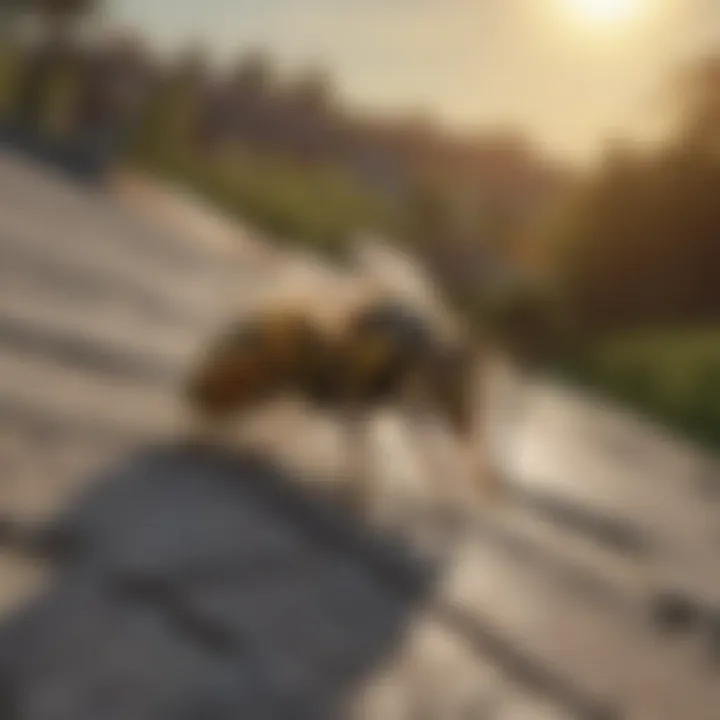
Ongoing monitoring for signs of re-infestation is essential after the removal of a wasp nest. Wasps can establish new nests if appropriate conditions exist. Homeowners should remain vigilant and look for:
- Increased Wasp Activity: Pay attention to increased wasp sighting around the former nest location. Noticing wasps repeatedly in the area may indicate they are trying to build a new nest.
- New Nest Formation: Inspect the surrounding areas regularly for new nests. Early detection allows for quicker action and can often mitigate larger infestations.
- Attractant Sources: Keep an eye on any potential attractants such as food residues or open trash containers nearby. Reducing these can lower the chances of wasp attraction.
"Monitoring is the first step in proactive pest management. Regular checks of roof spaces can save extensive future troubles."
By committing to these monitoring efforts, homeowners can help ensure that their living spaces remain free from wasps in the long term.
Preventing Future Wasp Nests
Preventing future wasp nests is crucial not only for safeguarding your home but also for ensuring a quality living environment. Many homeowners find themselves dealing with wasps more than once, and this often results from a lack of awareness regarding preventive measures. By effectively reducing the conditions that attract wasps, it is possible to minimize the likelihood of their return. Understanding what draws these insects can provide valuable insight, making prevention much easier.
Identifying Attractants
Identifying attractants is the first step in any effective prevention strategy. Wasps are drawn to specific food sources and shelter. Common attractants include:
- Sweets: Leftover food, sugary drinks, and open garbage bins can entice wasps.
- Protein Sources: Foods like meat or fish can attract them, especially during late summer when wasps are looking for protein for their young.
- Natural Shelter: Cracks and crevices in roofs or siding provide ideal nesting sites. Old furniture or garden tools left outside can also serve as potential wasp habitats.
To reduce these attractants:
- Secure Food Sources: Store food in sealed containers and clean spills promptly.
- Remove Garbage Regularly: Ensure bins are tightly closed and cleaned regularly to eliminate odors.
- Inspect Your Property: Regularly check for potential nesting sites and perform preventative repairs.
Effective Exclusion Techniques
Effective exclusion techniques form the backbone of a proactive approach to pest management. These strategies aim to create an environment that is unwelcoming to wasps, thereby discouraging them from nesting in the first place. Consider these techniques:
- Seal Entry Points: Inspect and seal off any gaps or cracks in walls, roofs, and around windows. Use caulk or expanding foam to close off these access points.
- Install Screens: Use fine mesh screens over vents and chimneys to block wasp entry while allowing ventilation.
- Trim Vegetation: Keep trees and bushes trimmed back from your home. This reduces the likelihood of wasps finding shelter close to your roof.
- Use Decoys: Some homeowners have found success with decoy nests. Wasps tend to be territorial. Hanging a decoy can discourage them from establishing a nest in proximity.
Regular maintenance is vital. Periodically review your home’s exterior for changes that may have occurred over time, which can create new attractants or entry points.
"Prevention is always better than cure. Understanding how to deter wasps is key."
By recognizing attractants and implementing effective exclusion techniques, homeowners can significantly reduce the likelihood of future wasp nests. This not only provides a safer living space but also eliminates the stress and risks associated with dealing with wasp infestations.
Considerations for Eco-Friendly Pest Management
Eco-friendly pest management is crucial in today’s context where the demand for sustainable practices grows. When dealing with wasp nests in roof spaces, it's vital to consider the impact of removal strategies not only on the pests but also on the broader ecosystem. Choosing environmentally responsible methods helps protect beneficial insects and minimizes harm to the environment. It promotes a more balanced ecosystem while effectively addressing the issue at hand.
Sustainable Practices for Pest Control
Adopting sustainable practices involves using selective methods that reduce pollution and harm to other species. Here are some effective strategies for eco-friendly pest control:
- Natural Repellents: Use repellents made from essential oils such as peppermint, clove, and geranium. These can deter wasps without harsh chemicals.
- Physical Barriers: Ensure proper sealing of roof spaces and other entry points. Utilize mesh screens or wire to block access to potential nesting areas.
- Bait Traps: Homemade traps can be used to lure wasps away. A mixture of sugar water and vinegar can attract and trap wasps, reducing their numbers without toxic substances.
- Encouraging Predators: Promote the presence of natural predators, such as birds that eat wasps. Planting native species nearby can support local wildlife.
Evaluating the Environmental Impact
When opting for any pest management solution, it’s essential to evaluate the overall environmental impact. Considerations include:
- Biodiversity: Assess how removal efforts affect local biodiversity. Reducing wasp populations should not come at the expense of other pollinators.
- Soil Health: Chemical methods can leach into the soil and impact soil organisms. Choosing biodegradable options helps maintain soil health and balance.
- Water Sources: Runoff from treatments can contaminate water sources. Ensure that products used do not pose a risk to nearby lakes, rivers, or drinking water.
By prioritizing eco-friendly strategies, homeowners can manage wasp infestations effectively while safeguarding the environment for future generations.
Culmination
In any effective pest management program, understanding both the challenges and solutions regarding wasp nests is essential. This is particularly true for homeowners who may find themselves in conflict with these insects in their roof spaces. Properly addressing wasp infestations not only protects individual well-being but also preserves the integrity of a home.
Summarizing Effective Wasp Management
Eliminating wasp nests requires a methodical approach. First, identification is critical. Recognizing the types of wasps present can influence the choice of removal method. Next, safety precautions must be taken seriously. Protective clothing plays a role in mitigating risks during removal efforts.
Following precautionary steps, the methods for nest removal can vary. Chemical solutions, while effective, should be used with caution, especially around children and pets. Natural remedies may present a less toxic alternative, appealing to environmentally conscious homeowners. Additionally, engaging professional services can provide peace of mind and expertise that some may lack.
Once the nest is removed, post-removal actions are equally crucial. This includes cleaning the area and monitoring any signs of re-infestation. Implementing preventive measures is important. Identifying attractants and employing exclusion techniques help ensure that new nests do not form.
Finally, it’s vital to consider eco-friendly pest management practices to protect not only oneself but also the surrounding environment. Understanding the ecological implications creates a balanced approach to pest control. Thus, effective management of wasp nests contributes to a safer and more harmonious living environment.



